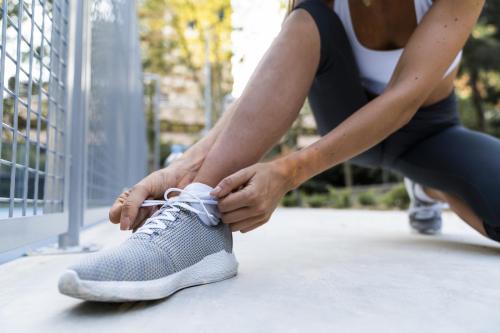Woah: You should lace your shoes based on your foot type, according to a podiatrist
Turns out there are different shoelace patterns for different kinds of feet. A podiatrist explains the techniques you should use for high arches, wide feet, etc.

Growing up, my parents were the ones who dealt with my shoelaces. They taught me the bunny ear trick, sure, but lacing up my sneakers was a whole different story. Nowadays, I just pray the shoes come already laced and ready to go—and if they don’t, I haphazardly put the shoelaces through the holes, hoping it results in a decent enough result that keeps my shoes on my feet.
But then my colleague told me this a.m. that he has a special trick for lacing his sneakers that’s specifically designed for those with high arches (like himself—hi Jamie!)—which led me down into a whole spiral of thoughts like “Why did I never know there are shoe-lacing methods for different feet types?!” and “Have I lived under a rock for 30 years?” With feet that don’t have a high arch, I’m now curious whether I require a certain arch-lacking lacing technique. And so I consulted a podiatrist for the low-down once and for all.
“The lacing of a shoe can impact the way that pressure is put on the top of the foot, or the way the foot is secured in the shoe,” explains Dr. Emily Splichal, DPM, MS, a New York-based podiatrist. “The factory standard of X-patterned lacing doesn’t work for all foot types and can actually put pressure on the toes and the nerves on the top of your feet.” I feel like my world has been turned upside down.
It’s not that every single person should be looking into special lacing patterns—it’s mainly for certain foot types. “A high-arched foot or a foot that has bony spurs on the top of their feet are at risk of increased pressure on the nerves due to various lacing patterns,” says Dr. Splichal. “And that pressure on the nerves can cause the foot to fall asleep when working out or a burning pain.” For these foot types, Dr. Splichal recommends parallel laces, like the below.
If your feet happen to be really narrow, or you have a narrow heel, you may also want to consider different lacing. “A foot that’s slipping in the shoes due to a narrow heel or narrow foot will want to change the lacing to go all the way up to the top eyelet on the sneaker,” she says. “This prevents the forward slipping of the foot in the shoe, which can lead to blisters or blood under the toenails.” You can watch that technique below.
Another foot at risk? Those who have a wide “forefoot” or if you’re dealing with bunions. “The increased width of the front of the foot can put extra pressure on the sides of the foot and toes,” says Dr. Splichal, noting that this calls for skipping the first couple of eyelets. “This will allow more room for the forefoot.” You can check out that method in the below video.
Your feet are all unique snowflakes, after all.
Speaking of those toes, here are some foot stretches for pain to try out (they all feel like a massage). And these are the best sneakers for walking, if you’re on your feet all the time.
Sign Up for Our Daily Newsletter
Get all the latest in wellness, trends, food, fitness, beauty, and more delivered right to your inbox.
Got it, you've been added to our email list.










